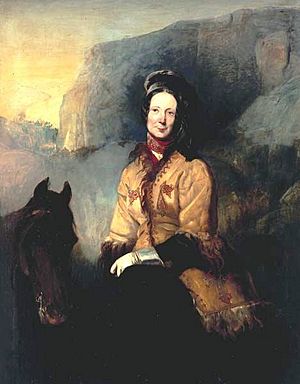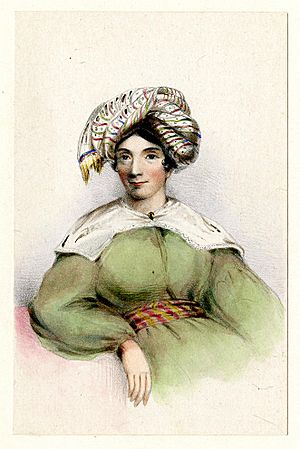Florentia Sale facts for kids
Quick facts for kids
Florentia Sale
|
|
|---|---|

Sale by Richard Thomas Bott, 1844
|
|
| Born |
Florentia Wynch
13 August 1790 |
| Died | 6 July 1853 (aged 62) Cape Town, South Africa
|
| Nationality | British |
|
Notable work
|
A Journal of the Disasters in Afghanistan, 1841–2 |
| Spouse(s) | Sir Robert Henry Sale (1809–1845) |
Florentia Sale (born Wynch; 13 August 1790 – 6 July 1853) was a brave Englishwoman. She traveled all over the world with her husband, Sir Robert Henry Sale. He was an officer in the British army.
People called her "the Grenadier in Petticoats." This nickname showed how tough and adventurous she was. She went with the army to many places. These included Mauritius, Burma, Afghanistan, and India. These lands were all part of the British Empire at the time.
Contents
Early Life and Education
Florentia Wynch was born on 13 August 1790. Her birthplace was Madras, in India. At that time, India was ruled by the British East India Company. Her father, George Wynch, worked for the civil service there.
Florentia's grandfather, Alexander Wynch, was once the Governor of Madras. She might have been named after her grandmother, Florentia Craddock. Florentia was raised by her uncles. She received a good education when she was young.
Marriage and Family Life
In 1809, Florentia Wynch married Robert Henry Sale. He was a soldier in the British Army. She went with him to his many army assignments. She raised their children while he was fighting.
Their first child, Mary Harriet, was born in 1810 in Walajabad. Their second child, George Henry, was born in 1811 in Port Louis, Mauritius. Her husband was stationed there. Five more of their children were born in Port Louis.
In 1820, her eighth child, Henrietta Sarah, was born in France. Her last child, Alexandrina, was born in 1823 in Calcutta, India. All of her children later married into families connected to India.
Captured in Afghanistan
During the First Anglo-Afghan War, Lady Sale faced a very difficult time. In 1842, she and other women, children, and soldiers were captured. This happened during the British Army's retreat from Kabul. They were held hostage for nine months.
Akbar Khan took them prisoner. This happened after a terrible event in the Khurd Karbul Pass. Lady Sale's youngest daughter, Alexandrina, was with her. Alexandrina's husband, Lieutenant John Sturt, was also a hostage.
Lieutenant Sturt was badly hurt in an attack. Lady Sale was shot in the wrist. Her daughter's pony was also shot. Lady Sale and her daughter cared for him until he died. She made sure he received a Christian burial.
After nine months, the group managed to talk with their Afghan captors. They were finally released. Sir Richmond Shakespear rescued them on 17 September 1842.
Her Famous Book
While she was a prisoner, Lady Sale kept a diary. She wrote down all the events of her capture. Her writing was very clear and thoughtful. She even sent parts of her diary to her husband. He then sent them to authorities in England. Newspapers at the time quoted her words.
She was not happy with how the newspapers reported her actions. A year later, she published her diary as a book. It was called A Journal of the Disasters in Afghanistan, 1841–42. The book shared her experiences during the Afghan War. It was highly praised by many people.
During her time in Afghanistan, Lady Sale also collected old coins. She gave 20 of these coins to the British Museum. One of these coins is still on display there today.
Later Life and Legacy
Lady Sale's husband died in battle in 1845. She became a widow. From 1846 to 1848, she lived in a special apartment. This was at Hampton Court Palace, near London.
She lived most of the rest of her life in India. After her husband's death, she received a yearly payment of £500. This was given to her because of her brave actions as a prisoner. It also honored her husband's military service.
In 1853, Lady Sale traveled to the Cape of Good Hope for her health. However, she died soon after arriving. She passed away on 6 July 1853, in Cape Town, South Africa.
Lady Sale was first buried in the Somerset Road Cemetery. Later, her monument and remains were moved. They are now in the Maitland Cemetery in Cape Town. Her tombstone reads, "underneath this stone reposes all that could die of Lady Sale."
Images for kids



